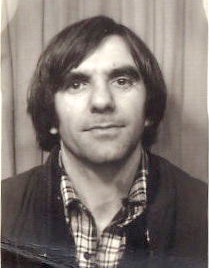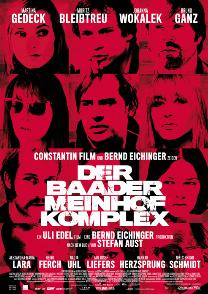
The Red Army Faction, also known as the Baader–Meinhof Group or Baader–Meinhof Gang, was a West German far-left militant organization founded in 1970. Key early figures included Andreas Baader, Ulrike Meinhof, Gudrun Ensslin, and Horst Mahler, among others. The government of the Federal Republic of Germany, as well as most Western media and literature, considered the Red Army Faction to be a terrorist organization.

The Ministry for State Security (German: Ministerium für Staatssicherheit, MfS or State Security Service, commonly known as the Stasi, was the official state security service of the German Democratic Republic. It has been described as one of the most effective and repressive intelligence and secret police agencies ever to have existed. The Stasi was headquartered in East Berlin, with an extensive complex in Berlin-Lichtenberg and several smaller facilities throughout the city. The Stasi motto was Schild und Schwert der Partei, referring to the ruling Socialist Unity Party of Germany and also echoing a theme of the KGB, the Soviet counterpart and close partner, with respect to its own ruling party, the Communist Party of the Soviet Union. Erich Mielke was the Stasi's longest-serving chief, in power for 32 of the 40 years of the GDR's existence.

Ulrike Marie Meinhof was a German left-wing journalist and founding member of the Red Army Faction (RAF) in West Germany, commonly referred to in the press as the "Baader-Meinhof gang". She is the reputed author of The Urban Guerilla Concept (1971). The manifesto acknowledges the RAF's "roots in the history of the student movement"; condemns "reformism" as "a brake on the anti-capitalist struggle"; and invokes Mao Zedong to define "armed struggle" as "the highest form of Marxism-Leninism".

Gudrun Ensslin was a founder of the West German far-left militant group Red Army Faction. After becoming involved with co-founder Andreas Baader, Ensslin was influential in the politicization of his anarchist beliefs. Ensslin was perhaps the intellectual head of the RAF. She was involved in five bomb attacks, with four deaths, was arrested in 1972 and died on 18 October 1977 in what has been called Stammheim Prison's "Death Night."

The 2 June Movement was a West German anarchist militant group based in West Berlin. Active from January 1972 to 1980, the anarchist group was one of the few militant groups at the time in Germany. Although the 2 June Movement did not share the same ideology as the Red Army Faction, these organizations were allies. The 2 June Movement did not establish as much influence in Germany as their Marxist counterparts, and is best known for kidnapping West Berlin mayoral candidate Peter Lorenz.

Alfred Willi Rudolf Dutschke was a German Marxist sociologist and a political activist in the German student movement and the APO protest movement of the 1960s.
Jan-Carl Raspe was a member of the German militant group, the Red Army Faction (RAF).

Charlottenburg is a locality of Berlin within the borough of Charlottenburg-Wilmersdorf. Established as a town in 1705 and named after late Sophia Charlotte of Hanover, Queen consort of Prussia, it is best known for Charlottenburg Palace, the largest surviving royal palace in Berlin, and the adjacent museums.

Raimund Pretzel, better known by his pseudonym Sebastian Haffner, was a German journalist and historian. As a wartime émigré in Britain, Haffner argued that an accommodation was impossible not only with Hitler but also with the German Reich with which Hitler had gambled. Peace could be secured only by rolling back "seventy-five years of German history" and restoring Germany to a network of smaller states.

The Deutsche Oper Berlin is a German opera company located in the Charlottenburg district of Berlin. The resident building is the country's second largest opera house and also home to the Berlin State Ballet.

Heinrich Albertz was a German Protestant theologian, priest and politician of the Social Democratic Party (SPD). He served as Governing Mayor of Berlin from 1966 to 1967.

The West German student movement or sometimes called the 1968 movement in West Germany was a social movement that consisted of mass student protests in West Germany in 1968; participants in the movement would later come to be known as 68ers. The movement was characterized by the protesting students' rejection of traditionalism and of German political authority which included many former Nazi officials. Student unrest had started in 1967 when student Benno Ohnesorg was shot by a policeman during a protest against the visit of Mohammad Reza Pahlavi, the Shah of Iran. The movement is considered to have formally started after the attempted assassination of student activist leader Rudi Dutschke, which sparked various protests across West Germany. The movement would create lasting changes in German culture.
Josef Erwin Bachmann became widely known in Germany for his assassination attempt on the Marxist activist Rudi Dutschke, firing three bullets at him, on 11 April 1968. Bachmann was convicted of the attack and sentenced to seven years in prison. He committed suicide in 1970 while serving his sentence.
Georg von Rauch was a member of the left-radical Blues-Scene in West-Berlin at the end of the 1960s during the German student movement.
The Außerparlamentarische Opposition, was a political protest movement in West Germany during the latter half of the 1960s and early 1970s, forming a central part of the German student movement. Its membership consisted mostly of young people disillusioned with the grand coalition of the Social Democratic Party of Germany (SPD) and the Christian Democratic Union (CDU). Since the coalition controlled 95 percent of the Bundestag, the APO provided a more effective outlet for student dissent. Its most prominent member and unofficial spokesman was Rudi Dutschke.

The Red Army Faction (RAF) existed in West Germany from 1970 to 1998, committing numerous crimes, especially in the autumn of 1977, which led to a national crisis that became known as the "German Autumn". The RAF was founded in 1970 by Andreas Baader, Gudrun Ensslin, Ulrike Meinhof, Horst Mahler, and others. The first generation of the organization was commonly referred to by the press and the government as the "Baader-Meinhof Gang", a name the group did not use to refer to itself.
Michael "Bommi" Baumann was a German author and former militant. After growing up in Berlin, he was radicalised by the police shooting of Benno Ohnesorg and founded the Movement 2 June with his best friend Georg von Rauch. After von Rauch was shot dead by the police and a bomb planted by Baumann killed a builder, Baumann fled abroad. Whilst on the run he wrote the memoir Wie alles anfing and renounced political violence. The book sold 100,000 copies. Baumann was arrested in London in 1981 and following a prison term lived in Berlin.

The Baader Meinhof Complex is a 2008 German drama film directed by Uli Edel. Written and produced by Bernd Eichinger, it stars Moritz Bleibtreu, Martina Gedeck, and Johanna Wokalek. The film is based on the 1985 German best selling non-fiction book of the same name by Stefan Aust. It retells the story of the early years of the West German far-left terrorist organisation the Rote Armee Fraktion from 1967 to 1977.

Karl-Heinz Kurras was a West German police inspector, known primarily for fatally shooting unarmed student Benno Ohnesorg in the back of the head during a demonstration on June 2, 1967, outside Deutsche Oper against the state visit of Mohammad Reza Pahlavi, the last Shah of Iran. Kurras was acquitted of any wrongdoing in a series of controversial trials, due to which he became a prominent hate figure of the left-wing German student movement of the 1960s as well as the German New Left. They suspected that Kurras was under protection from many right-wing figures in the West German police and justice system and who were resentful towards the left-wing students. The incident is considered pivotal for the rise of left-wing terrorism in West Germany during the 1970s, culminating with the Movement 2 June and the Red Army Faction.

Sadeq Tabatabaei was an Iranian writer, journalist, TV host, university professor at the University of Tehran and politician who served as Deputy Prime Minister from 1979 to 1980. He was also Deputy Minister of the Interior and oversaw the referendum on establishing an Islamic Republic in March 1979. He was Iran's Ambassador to West Germany from 1982 until 1986.
















